The winner of the Grand Prize at 2018’s YouFab Global Creative Awards, titled “Fish Hammer,” gives a harmless (seemingly harmless, anyway!) goldfish the power to smash miniature pieces of human furniture. In other words, it allows the fish to turn the tables, destroying a human environment the same way humans have been doing to fish for years. At the same time, its use of humorous, almost cartoonish images gives “Fish Hammer” a light touch.
In short, artist Neil Mendoza’s combination of playful, absurdist humor and serious environmental themes was a smash with the YouFab judges.
Mendoza sat down with Award Chairman Toshiya Fukuda to talk about his philosophy, the other pieces he submitted to the awards, and why he chose a goldfish in the first place.
Writer/Matt Schley, Photographer/Aya Suzuki, Editor/Mariko Suzuki
If a Goldfish Had a Hammer
Fukuda: To start off, could you describe “Fish Hammer” in your own words?
Mendoza: I like nature. Humans are part of nature. Often it’s tempting to think of ourselves as separate to nature. I’ve always been interested in working with animals, but it’s a difficult area, finding the dividing line between exploiting animals and working with them.
But I thought it might be possible to make something with a goldfish where he would be living in a similar habitat whether he was part of an art piece or just in an aquarium. I wanted to make something to empower a goldfish to smash up miniature human habitats, because we spend a lot of time destroying the fish habitat. That was the basic premise.
Fukuda: What was the initial inspiration?
Mendoza: I think it was a conversation I had with my friend about this idea of a fish controlled device and eventually we came up with a fish-controlled hammer. I wasn’t exactly sure what it was going to look like, but those two objects are quite iconic: a fish and a hammer. Separate from the meaning of the piece, I find those two concepts, fish and hammer, very pleasing.
Fukuda: You mentioned that fish are very iconic symbols. I think that’s especially the case with goldfish. The way they move, their simplicity, their peacefulness… I think using a goldfish was a really exquisite choice.
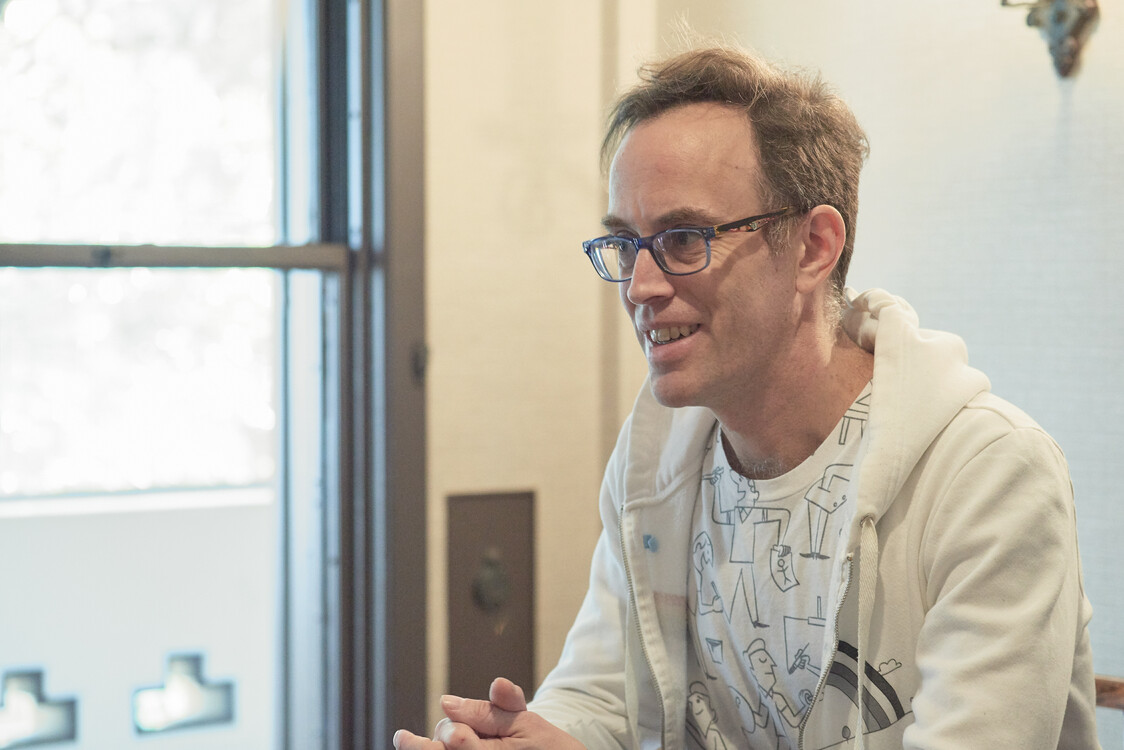
Mendoza: I think there was something humorous about using this kind of peaceful fish to destroy stuff. But also… this is the default fish. If you draw a picture of a fish, it’s going to be a goldfish. And also it’s a fish you picture as being someone’s pet. So reversing those roles and giving it the power to smash things appealed to me.
Fukuda: And the hammer is an iconic symbol too.
Mendoza: It’s just one of these things, like a tap—a faucet as they say in America—or a fish or a banana. They’re very aesthetically striking. They play a part in virtually every single culture on the planet. Unless you live in the middle of the jungle and aren’t familiar with modern society, everyone knows these objects. It’s interesting, then, taking them out of context and using them in unexpected ways, because they play very specific roles in people’s psyches.
Fukuda: Did you ever think of using another kind of fish?
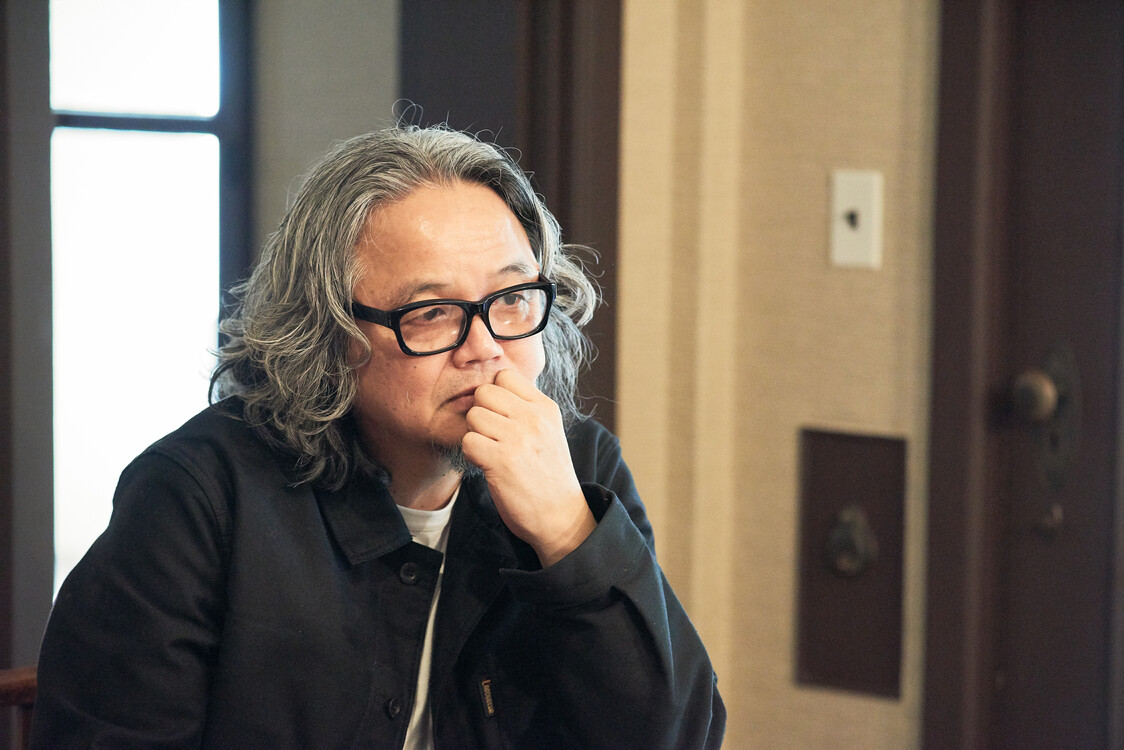
Mendoza: Originally I thought maybe a betta fish, a fighting fish, just because it has this fighting spirit. But I prefer the role goldfish play in people’s psyches. You know, it’s like if you watch like a Looney Tunes cartoon and it had a fish, it would be a goldfish. It’s just the default comedy fish (laughs).
Fukuda: Right, the idea people have in their minds of goldfish is these docile creatures that wouldn’t hurt a fly. The divide between that and the fish in your piece smashing things is part of what makes it so great.
Mendoza: Yeah, I think that’s what adds to the appeal of the piece. Completely taking it out of context… this very beautiful creature being given hammer power.
Fukuda: “Fish Hammer” is both nonsensical and absurdist, yet it has a strong message. Is that something that’s important to you?
Mendoza: Yeah, I think a lot of my work is like that. Taking technology out of context, taking objects out of context, making something that seems absurdist and nonsensical, but at the same time connecting with people using that sense of absurdity. I think if you do that and make something strange it connects with people on a deeper level , because they’re interested in why they find it strange.
I hope it makes people reconsider technology as well. It’s this idea that technology can be anything, like something completely absurd. I’m trying to loosen up people’s imaginations about what technology can be, outside of, for example, a cell phone.
Fukuda: You wrote in your description of the piece: “People love to break ocean stuff. The Fish Hammer empowers fish to break people stuff.” To what degree did you want to include an environmental message in the piece?
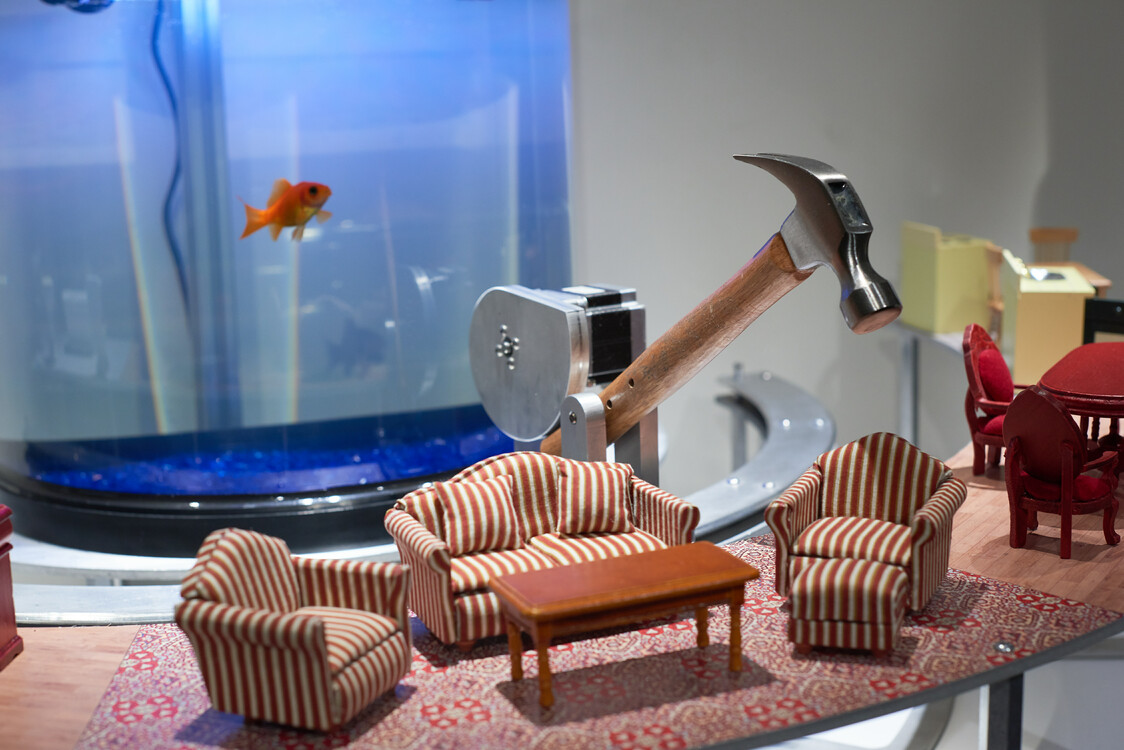
Mendoza: I knew I wanted a fish to be holding a hammer and destroying some kind of human habitat. But it took a while to come up with small furniture as the best thing for it to smash, trying to think of the best way to convey the message and create a strong visual composition.. The living room has all this consumer stuff we buy and enjoy. All of it has some kind of cost to nature to manufacture. So this iconic cute living room furniture started to make more sense, the more I thought about it. It’s a nice image, I think.
Fukuda: It makes me think, for example, of the image of a typical mother putting cooking oil down the drain. She knows she really shouldn’t do it, because it’ll go into rivers or the ocean and hurt fish. But she can’t really picture the consequences… they’re too far removed from her everyday life. But looking at this piece, you think to yourself, “oh, that’s right, we really shouldn’t be doing that!” It’s communicating not through logic, but through feeling. I think that’s part of what makes the piece so great.
Mendoza: That’s good. Definitely, a lot of trash just ends up in the ocean. I feel like until 20 or 30 years ago, everyone thought, “oh, the ocean is so big it doesn’t matter what we do, it’ll be fine.” And now it’s like, “oh, wait a minute, maybe it’s not fine!”
Fukuda: Why household furniture instead of, for example, commercial buildings?
Mendoza: I wanted to bring it back to people, individuals. Everyone sits around in their houses in their own little cocoon, separate from the rest of nature. I wanted to make the link between the environments we surround ourselves with and the global environment. I think if it were destroying something commercial, it would be easier to distance yourself from it, but in this case, you think, “this could be my living room.”
Fukuda: The environmental themes in the piece are definitely there, but they’re not too obvious—they don’t hit you over the head, so to speak.
Mendoza: I think in general, if you want to communicate with people through art, you can’t be too didactic. If it’s simply, “this is the message I’m trying to push across,” it becomes a very one dimensional piece. I think it should be something that people can appreciate on multiple levels, rather than being preachy and pushing messages down people’s throats. I also want to leave it up to the viewer to decide what it really means to them.
Beyond "Fish Hammer"
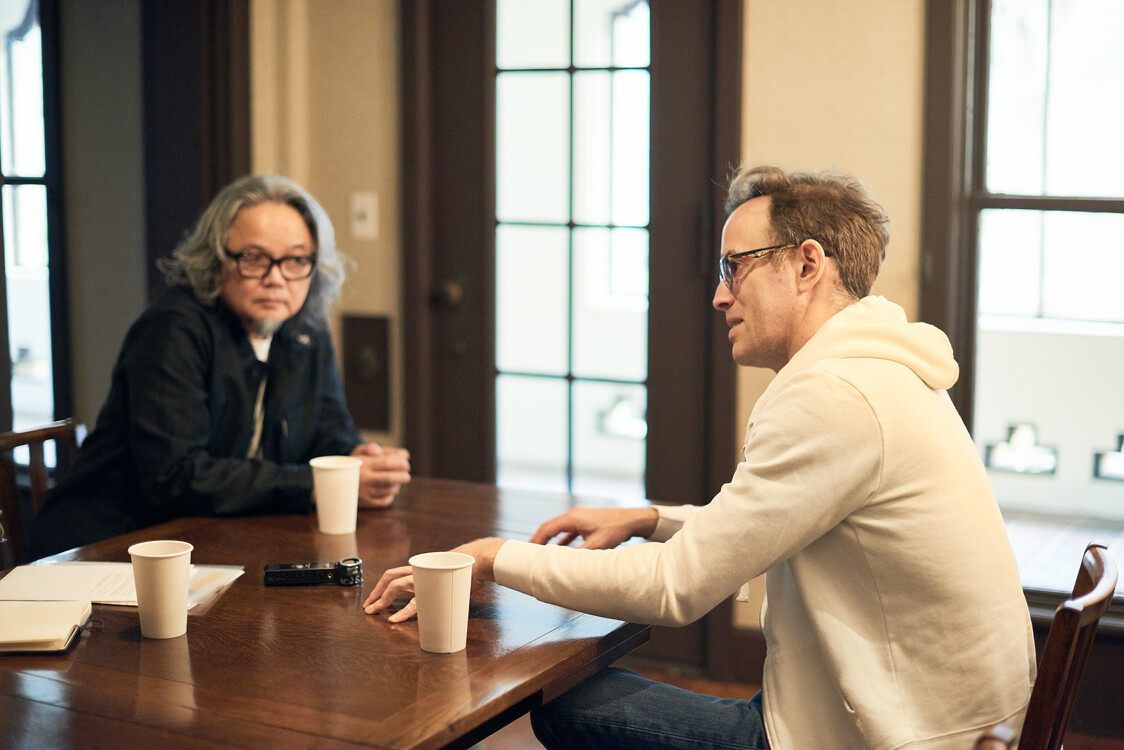
Fukuda: You submitted four other pieces for our competition. Could you describe those pieces in your own words? Let’s start with “Rock Band.”
Mendoza: “Rock Band” is electromechanical musical instruments that make music using rocks. A literal rock band. They play [The Beatles’] “Here Comes the Sun.” It’s an autobiographical story of a rock. A story of sitting on the ground waiting for the sun to rise every day. It was also made out of similar materials to “Fish Hammer.” That was fun.
Fukuda: What about “Hamster Powered Hamster Drawing Machine”?
Mendoza: You have a hamster, and as he runs around his wheel, he causes a machine to come to life which creates an image of a hamster using a drawing mechanism that encodes the lines in the drawing mechanically. It’s actually a recording of a hamster rather than a live hamster operating the machine. . I put a webcam in my friend’s pet hamster cage overnight and filmed it for 20 hours and had to edit it down to 20 minutes.
That piece started because I was interested in working out how I could encode a drawing mechanically. So I wrote some software and gave it a drawing, then it would output the mechanical pieces you needed to cut on a CNC machine to make a machine to draw the image you started with. It’s now at a Rube Goldberg exhibition in Pittsburgh.
Fukuda: Why a hamster?
Mendoza: Well, they’re cute and fluffy (laughs). Originally it was just a machine that drew hamsters. Then I decided it should be powered by a hamster too. Maybe it was just the appeal of the default small fluffy pet. It’s one of these pets that is very much domesticated. It’s a symptom of human society—changing nature by domesticating all these animals.
Fukuda: It feels like a commentary on the selfie generation too.
Mendoza: There’s a couple of things. There’s the selfie generation, and also some other commetary in there… he just works and works and works to create this drawing of himself. It’s kind of pointless work. There’s a bit of that in there too.
Fukuda: What about “Electric Knife Orchestra”?
Mendoza: It’s a musical piece that plays [the Bee Gee’s] “Stayin’ Alive” with 16 knives and one meat cleaver. The genesis was, I was playing around making musical machines, found a load of knives and started experimenting with them. It plays with this tension between music and these dangerous-looking objects. It’s interesting: when the machines are static and not moving, people find them quite threatening. But if they’re playing music, they want to go up and touch them. That’s really not a good idea because they’re sharp objects moving at high speed.
Fukuda: Did you use “Stayin’ Alive” because they’re deadly?
Mendoza: Right. I spent a while trying to work out what would be the best song for them to play. That seemed like the most suitable.
Fukuda: Finally, “Art 3.0.”
Mendoza: This one is a little bit more complicated to explain because it depends on [the cryptocurrency] Ethereum. First you need to know what Blockchain is, and you need to know what smart contracts are.
It’s kind of a comment on the art world. Some people buy stuff because it looks aesthetically pleasing, some people buy stuff because they want it as an investment, some people buy as a status symbol. So this piece, all it does is display its own value in bright LED digits. Anyone can buy it at any time by sending the amount it’s displaying to its smart contract. Then it’ll increase its price by 50 percent. The previous person who owned it gets a 40 percent profit, and the other 10 percent is split between the artist and the exhibiting institution.
Basically, it’s an art piece with its own business model built into it. You don’t need a gallery. You can just buy it from itself and it will work out how much it’s worth the next time it’s bought.
Normally in the art world, if someone like Andy Warhol sells a painting for a thousand dollars, and then 20 years later it goes for a million dollars, they don’t see a penny of that. But with this, the business model is part of the piece. It always pays the artist back in the end. And once you write the code and enable the smart contract, it can’t be altered.
Fukuda: Wow. It’s an art piece with its own built-in money. It’s an experiential piece that uses modern algorithms to comment on what’s happening in today’s economy. It’s not easy to understand, but now that you’ve explained it, I really feel like it represents something brand new for art.
The Path from Tech to Tech Plus Art
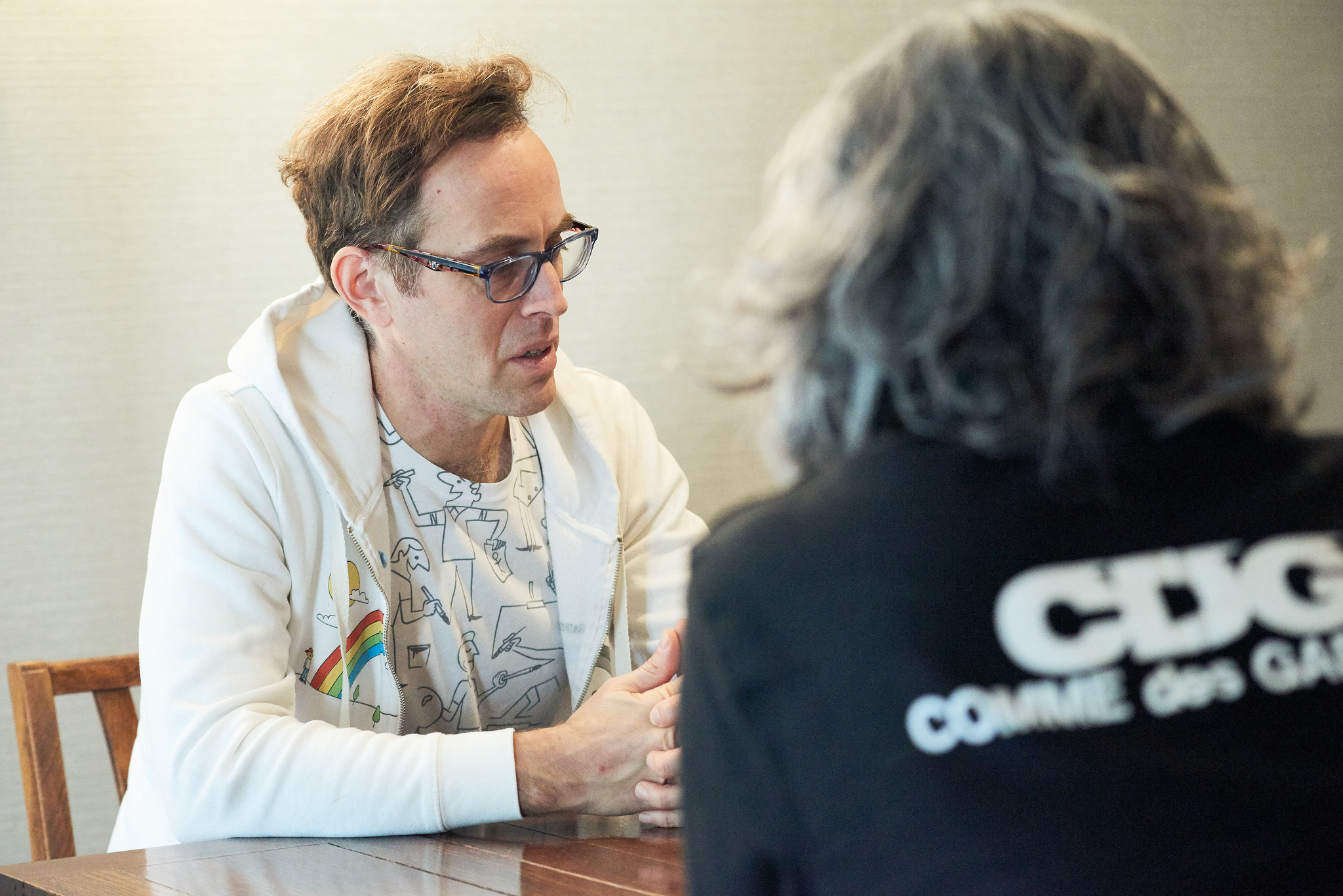
Fukuda: It sounds as if you’re quite skilled in the sciences as well as art. What caused you to choose your current path in the art world?
Mendoza: I started off in computer science. My first job was working for a computer games company, then I worked for a banking company doing web development, then for design agencies doing the same. But I always wanted to do more creative stuff. I wasn’t originally exposed to creative coding or anything fun like that.
Then at one of the design agencies I was freelancing for, there was someone doing work with Processing. That’s when I first realized that maybe I could actually do more creative stuff with technology and computers. Around 2014 I went back to graduate school to study art. That finished in 2016, after which I applied to the residency program at Autodesk. I like making physical stuff, and that’s a place where you can make anything you can dream of, essentially.
I think as an artist working today you have so many amazing tools available to you. But technology today is often used as a tool to sell you more stuff or get you more addicted to a social networking platform. I think it’s really powerful being able to do art without being constrained by the same kind of limitations that a company has. I think artists have a really valuable role in showing people what technology could be in an alternative future.
Fukuda: What new ideas or projects are you working on?
Mendoza: There’re a few different projects I’m interested in. I’ve been playing with combining more physical and virtual stuff. Machines which interact with screens and projections… combining mechanisms and computer graphics to make it feel like they’re one world.
I made a piece for a museum that allowed people to interact with famous paintings using physical contraptions That piece really appealed to people and I’m currently interested in doing more research in this area, potentially creating an architectural scale piece similar to that..
I’ve also been experimenting with some banana sculptures, so maybe a kinetic sculpture that allows you to store your bananas when you get back from the grocery store. My process involves a lot of research and experimentation. I like to get my hands dirty so ideas don’t always fully take shape until I’m fairly deep into a project. I’ll let you know when I find out what’s next!








